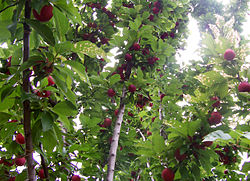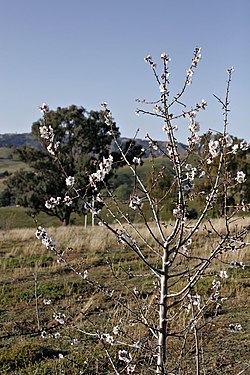Zhadd ani Follam


Voparincho hetu[बदल]
Tednam xisamnim lagim sorun Taka vicharlem: “Voparimnim tanchê kodde kiteak uloitai?” Tannem portipall kelo: “Kiteak Sorginchea Rajeache gutt vollkhunchem dennem tumkam dil’lem asa; tankam herank na. Asa tankam Dev anink-ui ditolo ani tanchem map bhoron òt’tolem; punn na tankam, asa tem porian tanchê koddlem Dev kaddun ghetolo. Dekhun Hanv voparimnim tanchê kodde uloitam, kiteak polleun-ui tankam disona, ani aikun-ui tankam aikona ani somzo-i na.
Izaiasan oxem adinch sanglolem tem tanchê sovem pallon ieta:
‘Aikun-aikun tumkam kãi, somzochem na; polleun-polleun tumkam kãi dischem na. Kiteak hea lokachem kalliz zodd-nibor zalam, tanche kan bhere zaleat, tanche dolle dhamplole asat; na tôr dolleamnim tankam disunk lagtolem, kanamnim tankam sarkem aikunk melltolem, monan tankam somzotolem, ani, tim Mhojê-xim portun ieun, Hanv tankam borim korin .’
Zhadd ani Follam[बदल]
Povitr Pustok ː Matev 7 ː 15-20
15 "Fottkirea provadiam vixim chotraien ravat; menddreanchem rupnnem gheun tumchê-xim ietat, punn bhitorlean krur landdge te. 16 Tanchim follam polleun tumi tankam vollkhun kaddtoleat. Kanttiancheô konnem dakô kaddleat zait? Ani sorantteanchim konnem anjiram kaddlim-xim asat? 17 Têch bhaxen, borem zhadd borim follam dita ani vaitt zhadd vaitt follam dita. 18 Borea zhaddachean vaitt follam dium nozo, nhoi mhonn vaitt zhaddachean borim follam dium nozo. 19 Borem foll dina toslem zhadd katortat ani ujeant uddoitat. 20 Dekhun tanchim follam polleun tumi tankam vollkhun kaddtoleat."
वपारिंचो हेतू[बदल]
तेदनां शिसांनीं लागीं सरून ताका विचारलें: “वपारिंनीं तांचê कडे कित्याक उलयताय?” ताणें पर्तिपाळ केलो: “कित्याक सर्गिंच्या राज्याचे गूट वळखुंचें देणें तुंकां दिल्लें आसा; तांकां हेरांक ना. आसा तांकां देव आनिंक-ऊय दितलो आनी तांचें माप भरन òत्तलें; पूण ना तांकां, आसा तें परियान तांचê कडलें देव काडून घेतलो. देखून हांव वपारिंनीं तांचê कडे उलयतां, कित्याक पळेवन-ऊय तांकां दिसना, आनी आयकून-ऊय तांकां आयकना आनी संजोय ना.
इजाय्ासान अशें आदिंच सांगललें तें तांचê सवें पाळन येता:
‘आयकून-आयकून तुंकां कांय, संजचें ना; पळेवन-पळेवन तुंकां कांय दिसचें ना. कित्याक ह्या लकाचें काळीज जड-निबर जालां, तांचे कान भेरे जाल्यात, तांचे दळे धांपलले आसात; ना तोर दळ्यांनीं तांकां दिसुंक लाग्तलें, कानांनीं तांकां सार्कें आयकुंक मेळतलें, मनान तांकां संजतलें, आनी, तीं म्हजê-शीं पर्तून येवन, हांव तांकां बरीं करीन .'
झाड आनी फळां[बदल]
पवित्र पुसतक ː मातेव ७ ː १५-२०
१५ "फटकीऱ्या प्रवादियां विशीं चत्राय्ेन रावात; मेनडऱ्यांचें रुपणें घेवन तुंचê-शीं येतात, पूण भितरल्यान क्रूर लानड्गे ते. १६ तांचीं फळां पळेवन तुमी तांकां वळखून काडतल्यात. कानटियांचेो कणें दाको काडल्यात जायत? आनी सरानट्यांचीं कणें आंजिरां काडलिंशीं आसात? १७ तêच भाशेन, बरें झाड बरीं फळां दिता आनी वायट झाड वायट फळां दिता. १८ बऱ्या झाडाच्यान वायट फळां दीवं नजो, न्हय म्हण वायट झाडाच्यान बरीं फळां दीवं नजो. १९ बरें फळ दिना तसलें झाड कातर्तात आनी उज्यांत उडयतात. २० देखून तांचीं फळां पळेवन तुमी तांकां वळखून काडतल्यात."
The Tree and its Fruits[बदल]
Scripture: Matthew 7:15-20
15 "Beware of false prophets, who come to you in sheep's clothing but inwardly are ravenous wolves. 16 You will know them by their fruits. Are grapes gathered from thorns, or figs from thistles? 17 So, every sound tree bears good fruit, but the bad tree bears evil fruit. 18 A sound tree cannot bear evil fruit, nor can a bad tree bear good fruit. 19 Every tree that does not bear good fruit is cut down and thrown into the fire. 20 Thus you will know them by their fruits.
Meditation:[बदल]
What do grapes, thorns, figs, and thistles have to teach us about the kingdom of God? The imagery used by Jesus would have been very familiar to his audience. A certain thornbush had berries which resembled grapes. And a certain thistle had a flower, which at least from a distance, resembled the fig. Isn't it the same today? What we "hear" might have a resemblance of the truth, but, in fact, when you inspect it closely, it's actually false. False prophets or teachers abound today as much as they did in biblical times. What's the test of a true or false teacher? Jesus connects soundness with good fruit. Something is sound when it is free from defect, decay, or disease and is healthy. Good fruit is the result of sound living — living according to moral truth and upright character. The prophet Isaiah warned against the dangers of falsehood: Woe to those who call evil good and good evil, who put darkness for light and light for darkness (Isaiah 5:20). The fruits of falsehood produce an easy religion which takes the iron out of religion, the cross out of Christianity, and any teaching which eliminates the hard sayings of Jesus, and which push the judgments of God into the background and makes us think lightly of sin. How do we avoid falsehood? By being true — true to God, his word, and his grace. And that takes character! Those who are true to God know that their strength lies not in themselves but in God who supplies what we need. The fruit of a disciple is marked by faith, hope and love, justice, prudence, fortitude and temperance. Do you cultivate good fruit in your life and reject whatever produces bad fruit?
"Lord, may I bear good fruit for your sake. Help me to reject whatever will produce evil fruit. And help me grow in faith, hope, love, sound judgment, justice, courage, and self control."
Meditations may be freely reprinted for non-commercial use. Cite copyright & source: www.dailyscripture.net author Don Schwager © 2014 Servants of the Word
